Shoulder arthroscopy is a minimally invasive surgical procedure that allows doctors to examine and treat various conditions affecting the shoulder joint. It involves making small incisions in the skin and inserting a thin, flexible instrument called an arthroscope, which has a camera and a light source at its tip. The arthroscope transmits images of the inside of the shoulder to a monitor, which helps the surgeon guide the surgical tools and perform repairs.
Some of the common reasons for shoulder arthroscopy are:
- Rotator cuff tears: The rotator cuff is a group of muscles and tendons that surround and stabilize the shoulder joint. It can get torn due to injury, overuse or degeneration.
- Shoulder instability: This occurs when the head of the upper arm bone (humerus) slips out of the socket (glenoid) of the shoulder blade (scapula), causing pain and reduced range of motion.
- Shoulder impingement: This happens when the space between the acromion (a bony projection on the top of the scapula) and the rotator cuff narrows, causing inflammation and irritation of the tendons.
- Bursitis: This is an inflammation of the bursa, a small sac of fluid that cushions and lubricates the joint.
- Arthritis: This is a degenerative condition that causes cartilage loss, bone spurs and inflammation in the joint.
Shoulder arthroscopy has several advantages over traditional open surgery, such as:
- Smaller incisions and scars
- Less pain and bleeding
- Faster recovery and return to normal activities
- Lower risk of infection and complications
However, shoulder arthroscopy also has some limitations and risks, such as:
- Not suitable for all types of shoulder problems
- Possible damage to nerves, blood vessels or other structures
- Possible stiffness, infection or recurrence of symptoms
Before undergoing shoulder arthroscopy, you will need to undergo some tests and preparations, such as:
- Physical examination and medical history
- Blood tests and imaging studies (such as X-rays, MRI or CT scan) to confirm the diagnosis and plan the surgery
- Stopping certain medications (such as blood thinners or anti-inflammatory drugs) that may increase bleeding or interfere with healing
- Fasting for several hours before the surgery
- Arranging for someone to drive you home and help you with daily activities after the surgery
During shoulder arthroscopy, you will be given general or regional anesthesia to numb your shoulder and make you unconscious or relaxed. You will be placed in a semi-seated or lying position on a special table. Your surgical team will shave hair (if needed) and clean your skin with an antiseptic solution. They may place your arm in a traction device to pull it away from your body and create more space for the arthroscope. A healthcare provider may inject fluid into your shoulder to expand the joint and improve visibility.
The surgeon will make one or more small incisions (about half an inch each) around your shoulder and insert the arthroscope through one of them. The surgeon will then insert other instruments through other incisions to perform various procedures, such as:
- Removing loose fragments of bone or cartilage
- Repairing torn ligaments or tendons
- Smoothing rough edges or removing bone spurs
- Reshaping or replacing damaged parts of the joint
The surgeon will close the incisions with stitches or adhesive strips and cover them with bandages. The surgery usually takes one to two hours, depending on the complexity of the procedure.
After shoulder arthroscopy, you will be taken to a recovery room where your vital signs will be monitored. You may feel some pain, swelling or numbness in your shoulder, which can be relieved by medication. You will be given instructions on how to care for your wound, prevent infection, manage pain and perform exercises to restore your shoulder function. You will also be given a sling or a brace to support your shoulder and limit its movement for several weeks.
You will be able to go home on the same day or stay overnight in the hospital, depending on your condition and preference. You will need to follow up with your doctor regularly to check your progress and remove your stitches. You will also need to undergo physical therapy to regain your strength, flexibility and range of motion. The recovery time varies from person to person, but it may take several months before you can resume your normal activities.
Shoulder arthroscopy is a safe and effective way to diagnose and treat many shoulder problems. However, it is not a cure-all solution and it may not work for everyone. You should discuss with your doctor





